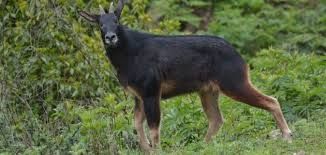First recorded human sighting of Himalayan serow
For the first time, a Himalayan Serow has been sighted in the Himalayan cold desert. The Himalayan Serow was earlier thought to be extinct in the Himalayas. Because, the forest officials could not spot them for the last ten to twelve years in spite of several special efforts to site the herbivore. It was recently captured in a camera by the state wildlife wing in Himachal Pradesh Spiti Valley for the first time.
Himalayan Serow
The Himalayan Serow is an extremely shy animal and can be sighted only during winters when it migrates to lower elevations. Thus, the spotting of the animal is rare. According to the Biologists, the Himalayan serow is resembling cross between a goat, cow, donkey and a pig. It is a medium sized mammal with thick neck, large head, short limbs, mule like ears and coat of dark hair. All the species of serows are found only in Asia. The Himalayan Serows are restricted only to Himalayan region. It is usually found at altitudes of two thousand to four thousand metres. They are only found in eastern, western and central Himalayas. They are not found in trans Himalayas.
Himalayan Serows Conservation
The Himalayan Serows have been facing decline in their population size due to habitat loss and is expected to continue due to intensive human impact. The International Union for Conservation of Nature had listed the Himalayan Serows as ‘Near Threatened’. The IUCN has now changed their status to ’vulnerable’. It has been listed under Schedule I of the Wildlife Protection Act, 1972. Also, it has been included in CITES Appendix I.
Spiti Valley
The valley is located in Himachal Pradesh. It is a cold desert mountain valley located high in Himalayas in the north eastern parts of the state of Himachal Pradesh. Spiti means ‘Middle Land’, that is, the land between Tibet and India.
Month: Current Affairs - December, 2020


